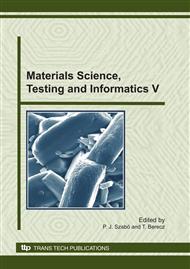p.159
p.165
p.171
p.177
p.183
p.191
p.197
p.203
p.209
The Change of the 3D Printing Product Mechanical Properties in the Function of Different Post-Treatment
Abstract:
Rapid prototyping (RP) has changed the method of product design and manufacturing. With the help of RP technologies a physical model can be created within couple of hours from any complex CAD model. RP technologies in contrast with conventional subtractive manufacturing technologies produce the end product by adding material layer-by-layer. 3D printing is one of the most widespread technologies in the industry. Because of the porous structure and bad mechanical properties of the models further post treatment is needed. Post treatment always means infiltration of the models, in case of gypsum and cellulose epoxy resin is mostly used. In our work the effect of post treatment method was examined on the mechanical properties of the pieces. The investigated pieces were prepared with four different setting of a printer.
Info:
Periodical:
Pages:
183-189
Citation:
Online since:
September 2010
Authors:
Keywords:
Price:
Сopyright:
© 2010 Trans Tech Publications Ltd. All Rights Reserved
Share:
Citation:


